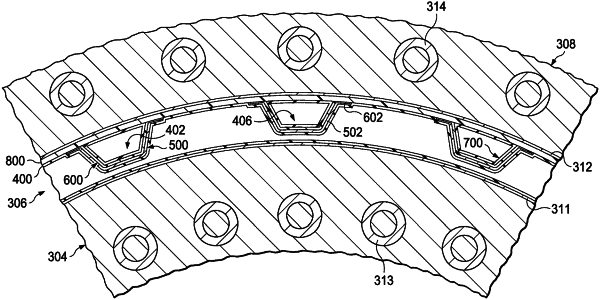| CPC B64F 5/10 (2017.01) [B29C 35/0805 (2013.01); B29C 70/44 (2013.01); B29C 2035/0811 (2013.01); B29L 2031/3082 (2013.01)] | 24 Claims |

|
1. A method for forming a composite structure, the method comprising:
holding an inner tooling, a stackup, and an outer tooling in place together using a load constraint, wherein in at least one cross-section the stackup surrounds the inner tooling, the stackup comprising a bladder surrounding the inner tooling;
pressurizing the bladder and a plurality of stringer bladders in the stackup to cause expansion and inflation of the bladder and the plurality of stringer bladders, thereby pushing together an overbraided thermoplastic skin and a plurality of overbraided thermoplastic members in the stackup,
wherein the bladder comprises a plurality of recessed portions and a plurality of caps, each of the recessed portions being located between corresponding two caps of the plurality of caps, wherein each of the plurality of overbraided thermoplastic members and a corresponding one of the stringer bladders are at least partially positioned in a corresponding one of the recessed portions, each of the plurality of overbraided thermoplastic members being at least partially positioned in the corresponding one of the recessed portions between the corresponding one of the stringer bladders and the bladder; and
wherein a surface of at least one recessed portion of the plurality of recessed portions comprises a base section, and comprises a first section extending away from the base section, wherein in a cross-sectional view in which the first section is at a higher level than the base section, at least a portion of the corresponding overbraided thermoplastic member extends laterally beyond a circumferential profile of the base section to overlie at least a portion of the first section; and
co-consolidating the overbraided thermoplastic skin and the plurality of overbraided thermoplastic members while the bladder and the plurality of stringer bladders are pressurized to form the composite structure;
wherein the co-consolidating uses inductive heating generated from induction coils which are at least partially embedded in the inner tooling and, in the at least one cross-section, are surrounded by the pressurized bladder.
|